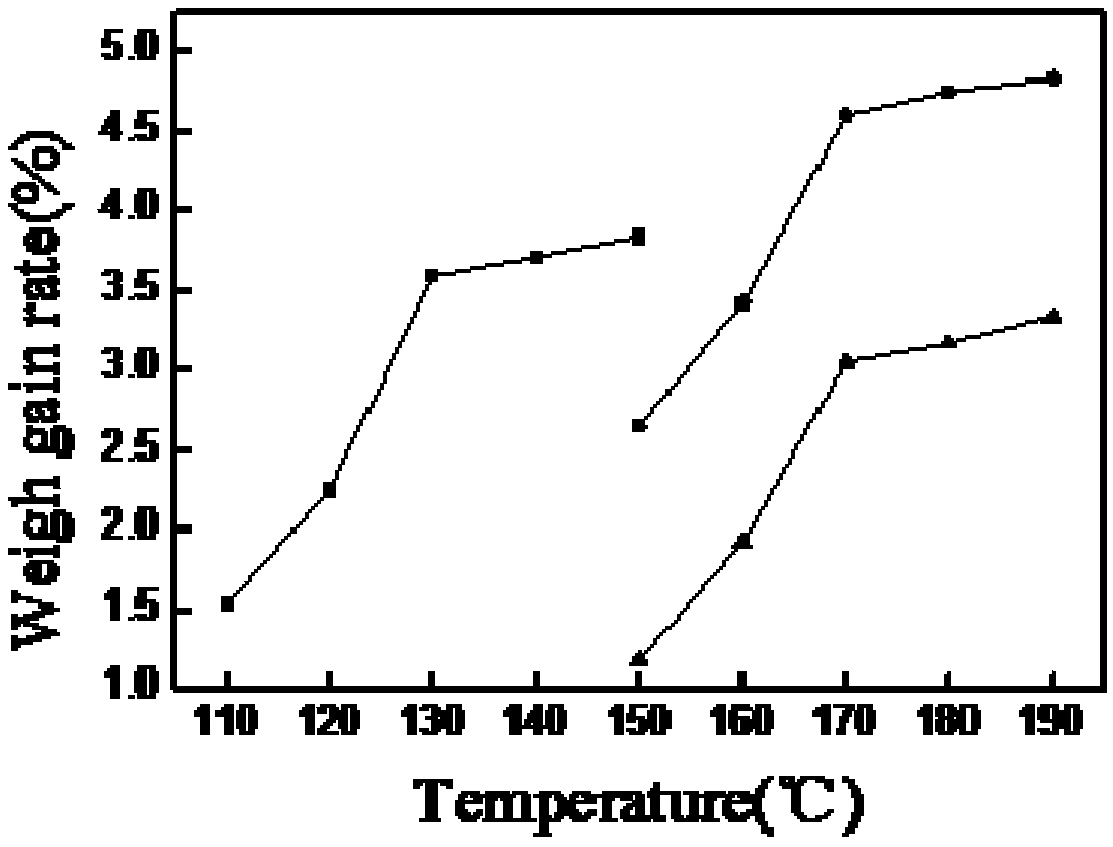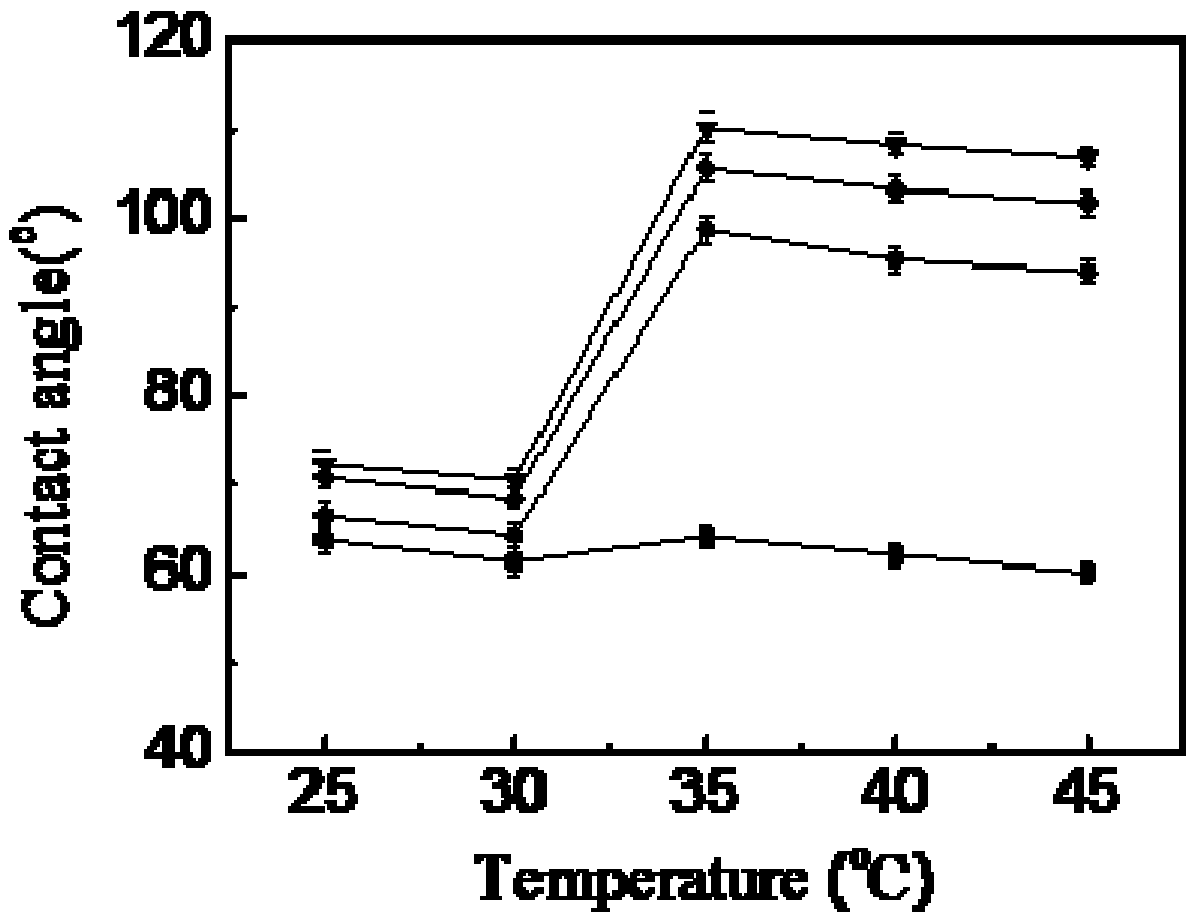Method for reducing preparation cost and improving cleaning efficiency by increasing crosslinking efficiency
A technology of cross-linking efficiency and cost, which is applied in textiles and papermaking, fiber treatment, plant fibers, etc., and can solve the problems of low efficiency, high synthesis cost and high cost of smart clean textiles
- Summary
- Abstract
- Description
- Claims
- Application Information
AI Technical Summary
Problems solved by technology
Method used
Image
Examples
Embodiment 1
[0036] This embodiment is a method for reducing preparation cost and improving cleaning efficiency by improving cross-linking efficiency. Utilizing the hydroxyl group contained in the temperature-sensitive copolymer and the pure cotton fabric, which can react with the carboxyl group contained in citric acid, the temperature-sensitive copolymer is fixed on the surface of the pure cotton fabric through a cross-linking reaction, including the following steps: 1) uncrosslinked Cotton fabrics with temperature-sensitive polymers are placed in a constant temperature and humidity room (temperature (20 ± 2) o C, humidity (65±3)% ) for 24 h, weighed after reaching equilibrium, and obtained the mass m 1 ; put P(MEO 2 MA 94 - co -EGMA 17 ) molecular formula ( ) 8%, citric acid 2.3%, sodium hypophosphite 1.2%, and water 88.5% to make a solution; 2) Soak the pure cotton fabric in the solution, take it out, dip and roll twice; 3) put it in a 60°C oven at 130°C Bake for 2 minutes; 4)...
Embodiment 2
[0038] A method of reducing preparation cost and improving cleaning efficiency by improving crosslinking efficiency in this embodiment; using the hydroxyl group contained in the temperature-sensitive copolymer and pure cotton fabric, it can be combined with 1,2,3,4-butane tetracarboxylic acid The characteristics of the contained carboxyl group reaction, the temperature-sensitive copolymer is fixed on the surface of pure cotton fabric by cross-linking reaction, including the following steps: 1) the cotton fabric of uncross-linked temperature-sensitive polymer is placed in a constant temperature and humidity room (temperature (20 ±2) o C, humidity (65±3)% ) for 24 h, weighed after reaching equilibrium, and obtained the mass m 1 ; put P(MEO 2 MA 94 - co -EGMA 17 ) molecular formula ( ) 8%, 1,2,3,4-butane tetracarboxylic acid 2.3%, sodium hypophosphite 1.2%, water 88.5% to make a solution; ;3) Place in a 60°C oven and bake at 170°C for 2 minutes; 4) Take out the pure cott...
Embodiment 3
[0040] This embodiment is a method for reducing preparation cost and improving cleaning efficiency by improving cross-linking efficiency. Utilizing the hydroxyl group contained in the temperature-sensitive copolymer and the pure cotton fabric, which can react with the carboxyl group contained in the polymaleic acid, the temperature-sensitive copolymer is fixed on the surface of the pure cotton fabric through a cross-linking reaction, including the following steps: 1) Cotton fabrics of uncrosslinked temperature-sensitive polymers are placed in a constant temperature and humidity room (temperature (20 ± 2) o C, humidity (65±3)% ) for 24 h, weighed after reaching equilibrium, and obtained the mass m 1 ; put P(MEO 2 MA 94 - co -EGMA 17 ) molecular formula ( ) 8%, polymaleic acid 2.3%, sodium hypophosphite 1.2%, and water 88.5% to make a solution; 2) Soak the pure cotton fabric in the solution, take it out, dip and roll twice; 3) put it in an oven at 60°C Bake at 170°C for...
PUM
 Login to View More
Login to View More Abstract
Description
Claims
Application Information
 Login to View More
Login to View More - R&D
- Intellectual Property
- Life Sciences
- Materials
- Tech Scout
- Unparalleled Data Quality
- Higher Quality Content
- 60% Fewer Hallucinations
Browse by: Latest US Patents, China's latest patents, Technical Efficacy Thesaurus, Application Domain, Technology Topic, Popular Technical Reports.
© 2025 PatSnap. All rights reserved.Legal|Privacy policy|Modern Slavery Act Transparency Statement|Sitemap|About US| Contact US: help@patsnap.com



